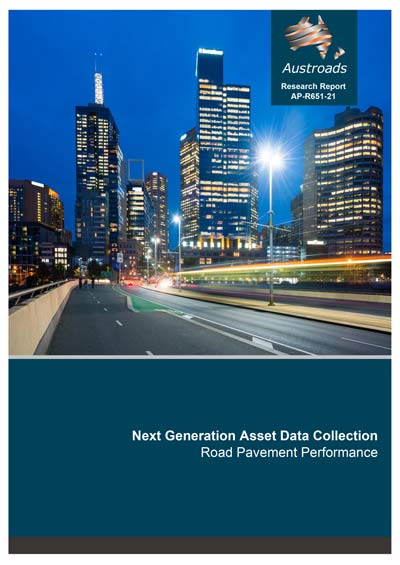Asset Management

- Publication no: AP-R651-21
- ISBN: 978-1-922382-66-5
- Published: 27 April 2021
- PDF (free) Download
This report identifies and evaluates technology solutions that meet asset management needs relating to road pavement performance.
The increasing pace of change of technology brings considerable promise of more data, of a higher quality, captured for a lower cost.
The report summarises current and emerging data collection technologies, and proposes and tests a technology evaluation framework.
The evaluation of emerging technologies found existing equipment, such as mobile phones, was often repurposed to develop new methods of data collection. While this occasionally results in lower accuracy, this is consistently offset by high affordability and other strengths such as higher frequencies of data collection, data redundancy and secondary benefits. Accordingly, even emerging data collection technologies with relatively low accuracies have a role to play in addressing the data needs of road controlling authorities, and may be used to augment, rather than replace, existing data collection programs.
Watch the webinar about the report below. Presented by David Jansen, Susan Chamberlain, Ella Hingston, Dr Colin Kemp and Trevor Chiang.
- Summary
- Abbreviations
- 1. Introduction
- 1.1 Background
- 1.2 Purpose
- 1.3 Scope
- 1.4 Methodology
- 1.4.1 Overview
- 1.4.2 Limitations
- 1.5 Report Outline
- 1.6 Definitions
- 2. Asset Management Data Needs
- 2.1 Background
- 2.2 Austroads Road Asset Data Standard
- 2.3 Strategic Asset Management Data Needs
- 2.3.1 Background
- 2.3.2 Demand Forecasting
- 2.3.3 Performance Measurement and Reporting
- 2.3.4 ‘State of the Asset Base’ Dashboards and Reporting
- 2.4 Operational Asset Management Data Needs
- 3. Network Performance Indicators
- 3.1 Background
- 3.2 Overview of Local and International Network Performance Indicators
- 3.2.1 Austroads National Performance Indicators
- 3.2.2 Australian and New Zealand Road Controlling Authorities
- 3.2.3 Road Controlling Authorities outside Australia and New Zealand
- 3.3 Overview of Approach to Developing Network Performance Indicators
- 3.4 Summary of Identified Themes
- 4. Current Data Collection Technologies
- 4.1 Overview
- 4.2 Summary of Current Data Collection Technologies
- 4.2.1 Visual Inspections
- 4.2.2 Handheld Measuring Equipment
- 4.2.3 Walking Profilers
- 4.2.4 Laser Profilometers
- 4.2.5 Integrated Network Survey Vehicles
- 4.2.6 Skid Resistance Measurement Systems
- 4.2.7 Benkelman Beams and Deflectographs
- 4.2.8 Falling Weight Deflectometers
- 4.2.9 Traffic Speed Deflectometers
- 4.2.10 Ground Penetrating Radar
- 4.2.11 Weigh-in-Motion Systems
- 4.2.12 Road Geometry Mapping and Measurement Systems
- 4.2.13 LiDAR
- 4.2.14 Road Noise Measurement Trailers
- 4.2.15 Traditional Traffic Detectors
- 4.2.16 Infrared Laser Traffic Loggers
- 4.2.17 ‘Traditional’ Bluetooth Detectors
- 4.2.18 Other Data Sources
- 5. Emerging Data Collection Technologies
- 5.1 Background
- 5.2 Evaluation Framework Development
- 5.2.1 Overview
- 5.2.2 Methodology
- 5.3 Summary of Emerging Data Collection Technologies
- 5.3.1 Collection of Road Roughness with Smart Phone Sensors
- 5.3.2 Assessment of Pavement Condition with Machine Learning and Street-Level Imagery
- 5.3.3 Collection of Pavement Distress Data and Road Roughness with Satellite Remote Sensing
- 5.3.4 Collection of Pavement Defect Data with Infrared Thermography
- 5.3.5 Pavement Structural Health Monitoring with Vibro-Acoustic Techniques
- 5.3.6 Assessment of Seal Age with Portable Fourier Transform Infrared Spectroscopy Devices
- 5.3.7 Collection of Sign Retro-Reflectivity with Computer Vision and Street-Level Imagery
- 5.3.8 Detection of Harsh Braking Locations with Smart Phone Sensors
- 5.3.9 Detection of Road Safety Hazards with V2X Communication
- 5.3.10 Detection of Road and Roadside Objects with Machine Learning and Street-Level Imagery
- 5.3.11 Utilisation of Colourised Point Clouds from Off-the-Shelf LiDAR Data
- 5.3.12 Collection of Vehicle Speeds, Travel Times and Origin-Destination Data with ‘New Generation’ Bluetooth Detectors
- 5.3.13 Collection of Traffic Count Data with Wireless Magnetometers
- 5.3.14 Estimation of Traffic Count Data, Vehicle Speeds and Origin-Destination Data with Proprietary Traffic Models
- 5.3.15 Collection of Various Traffic Data from Navigation Applications, Navigation System Providers, Mobile Phone Carriers, Mobile Operating System Providers and Rideshare Providers
- 5.3.16 Collection of Traffic Count Data, Traffic Classification Data and Near-Collision Data with Video Analytics Software and CCTV Video
- 5.4 Evaluation Framework Implementation
- 5.4.1 Results
- 5.4.2 Strategies for Implementing Evaluated Emerging Data Collection Technologies
- 5.5 Implications for Future Network Performance Indicators
- 6. Conclusion
- 7. Future Direction
- References
- Appendix A Completed Evaluation Scorecards
